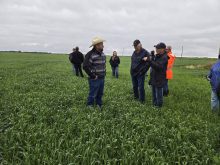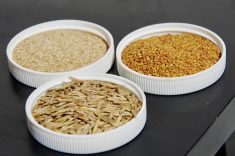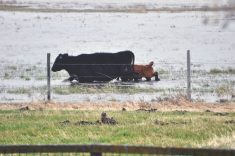Forage sellers may be aiming too high amid a softening hay market, according to a recent Hay Relief report from the Manitoba Forage and Grassland Association (MFGA).
“The producers that I’ve talked to who are looking at selling and/or buying hay are kind of finding that there’s not a lot of people buying hay right now because of either the price that they’re asking for it or the fact that there’s still uncertainty as to how much hay they’re going to actually end up putting up,” association hay expert John McGregor said.
Read Also

Pig transport stress costs pork sector
Popular livestock trailer designs also increase pig stress during transportation, hitting at meat quality, animal welfare and farm profit, Agriculture and Agri-Food Canada researcher says
Some producers are moving product, but at a few cents per pound less than the general asking price, he noted.
Why it matters: Better forage has been good news this year for livestock producers, especially after the stress of last year’s critical feed shortages, but hay prices have yet to fully drop back down.
The Sept. 10 report noted that feed shortfalls this year, “seem to be trending to localized areas rather than an overall provincial trend, and current asking prices may be set for a higher shortage than is likely to appear.
The MFGA put alfalfa prices at seven to 10 cents a pound, dairy alfalfa at 10 to 12 cents a pound and alfalfa-grass mixes ranging from six to 10 cents a pound for good-quality feed and down to five to eight cents a pound for beef quality (with similar prices for beef-quality grass). Producers selling greenfeed were asking seven cents a pound.
Standing native hay, meanwhile, was posted for an estimated two cents a pound and annual crops straw ranged from one to 2-1/2 cents a pound.
Producers this year have more options for their winter rations compared to the critically short forage supplies last year, McGregor noted. In 2019, dry weather and poor growing conditions burned off pastures, extended the feeding season on both ends into the spring and fall and created forage shortages that led over a dozen municipalities to declare states of agricultural emergency.
What hay was for sale quickly dwindled, even for producers willing to pay the rising price as demand pressure hit the hay market.
“We were buying grain. We were buying distillers grains. We were buying other products… this year, they’re going to have that option of buying good-quality hay versus, say, buying barley,” McGregor noted.
Growers still reported sparse first cuts in parts of the province this year, although timely rains likely rescued many second cuts and greenfeed and silage stands have been generally encouraging. Many producers planted greenfeed in 2020 as a buffer against the shortages seen in the last two years, McGregor noted.
Second cut was still anywhere from 50 per cent below average to average in eastern Manitoba, according to weekly provincial crop reports, and forage shortages are still expected in the Interlake, although not as critical as last year.
Peter Lemky of Carberry says he has seen 30 to 40 per cent of the interest he saw last year from producers looking to buy his bales.
Likewise, Lemky said, his asking price has dropped about 30 per cent, given more available feed in the region.
“There are certain pockets that are definitely short on hay, but when the producer pencils in the cost of hauling, they’re holding back,” he said.
Lemky is still looking for buyers for both his first- and second-cut bales.
Duane Zimmer of Russell also says most of his posted forage remains unsold, save for some sold to a neighbour. Last year at this time, much of his supply had been spoken for, thanks to one customer scooping up most of his forage in July.
“We’ll see what kind of interest there is come fall,” he said. “The hay price that I got last year, what I’m asking for now is 25 per cent less… hopefully I can still sell the bales that are on the field.”
Adam Campbell of Virden also noted the increase of available feed in his region. About a third of his posted forage has been sold, he reported, most to repeat customers. His asking prices have also dropped, given the decrease in demand.
“And I would say they’re still too high, just going by what I’m seeing,” he added.
His local area has shown, “quite an abundance,” of feed, he said, although he noted that many producers are also considering extra inventory as a safeguard against a possible poor crop next year.
“Generally speaking, this time of year guys are going around cutting ditches and doing everything they can to not have to buy as many bales,” he noted. “November is usually when we start getting an uptick in calls.”
The province has noted producers putting cattle onto greenfeed stubble or hayfields in some areas in an attempt to stretch grazing. Others have started supplemental feeding on poorer pastures, McGregor noted.




















